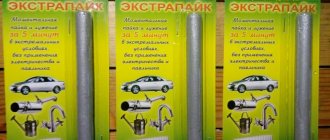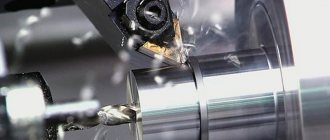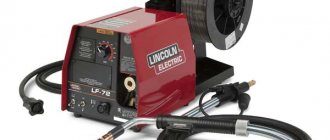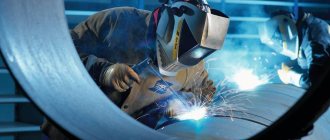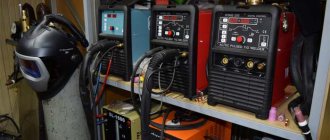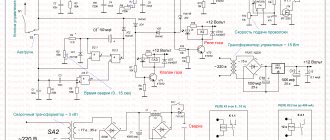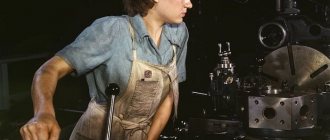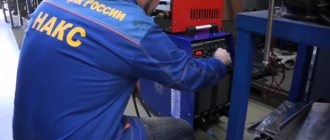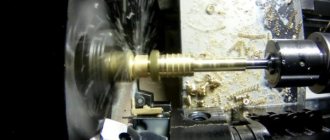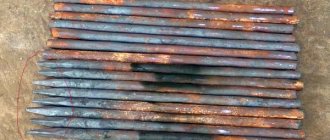First welding methods
arose at the origins of civilization - with the beginning of the use and processing of metals.
The oldest examples of welding are known, made in the 8th-7th millennia BC. The oldest source of metal was randomly found pieces of native metals - gold, copper, meteorite iron. They were forged into leaves, plates, and points. Forging with slight heating made it possible to connect small pieces into larger ones, suitable for the manufacture of simple products.
Later they learned to smelt metal from ores, smelt it and cast it to produce larger and often very advanced products from copper and bronze.
With the development of foundry production, foundry welding arose using the so-called intermediate casting method - the parts to be joined were molded, and the welding site was filled with molten metal. Subsequently, special low-melting alloys were created to fill connecting parts, and along with foundry welding, soldering appeared, which is of great importance even now.
A very important stage was the development of iron about 3000 years ago. Iron ores are available everywhere, and the reduction of iron from them is relatively easy. But in ancient times they did not know how to smelt iron, and from the ore they obtained a product consisting of tiny particles of iron mixed with particles of ore, coal and slag. Only by forging the heated product for many hours was it possible to squeeze out non-metallic impurities and weld the iron particles into a piece of commercial metal. Thus, the ancient method of producing iron involved the process of welding iron particles into larger pieces. From the resulting blanks, all kinds of products were made by forge welding: tools, weapons, etc. Centuries of experience, intuition and instinct allowed the ancient Misters to sometimes obtain very high quality steel (damask steel) and forge welding
produce products of amazing perfection and beauty.
Forge welding and soldering
were the leading processes in welding technology until the end of the 19th century, when a completely new, modern period of welding development began. The production of metal and all kinds of products made from it has increased disproportionately, and the need for welding work has increased manifold, which existing welding methods could no longer satisfy. The rapid development of welding technology began - in a decade it was improved more than in the century of the previous period. New heating sources that easily melted iron also developed rapidly: electric current and oxygen gas flame.
Of particular note is the discovery of the electric arc discharge, on the use of which electric arc welding is based - the most important type of welding of the present time. A prominent role in the creation of this method belongs to scientists and engineers of our country. The very phenomenon of arc discharge was discovered and studied in 1802 by Russian physicist and electrical engineer, later academician Vasily Vladimirovich Petrov
.
Petrov Vasily Vladimirovich
In 1802, Russian academician V.V. Petrov drew attention to the fact that when an electric current is passed through two rods of coal or metal, a dazzlingly burning arc (electric discharge) with a very high temperature appears between their ends. He studied and described this phenomenon, and also pointed out the possibility of using the heat of an electric arc to melt metals, and thus laid the foundations for arc welding of metals.
N.N. Benardos
in 1882
he invented a method of arc welding using a carbon electrode
. In subsequent years, he developed methods for checking with an arc burning between two or more electrodes; welding in a shielding gas atmosphere; resistance spot electric welding using pliers; A number of designs of automatic welding machines have been created. N.N. Benardos has patented a large number of different inventions in the field of welding equipment and welding processes in Russia and abroad.
Benardos Nikolay Nikolaevich
The author of the method of arc welding
with a consumable metal electrode
, the most common at present, is
N.G.
Slavyanov , who developed it
in 1888
Slavyanov Nikolai Gavrilovich
N.G. Slavyanov not only invented arc welding with a metal electrode, described it in his articles, books and patented it in various countries of the world, but he himself widely introduced it into practice. With the help of a team of welders trained by him, N.G. Slavyanov used arc welding to correct casting defects and restore parts of steam engines and various large equipment. N.G. Slavyanov created the first welding generator and automatic regulator of the length of the welding arc, and developed fluxes to improve the quality of the deposited metal during welding. Created by N.N. Benardos and N.G. Slavyanov welding methods were the basis of modern methods of electric welding of metals.
The introduction of welding into production was very intensive, so in Russia from 1890 to 1892, 1631 products were repaired with high quality using their technology, with a total weight of over 17 thousand pounds, these were mainly cast iron and bronze parts. They even developed a project to repair the Russian monument of the Tsar Bell foundry, but the work was not allowed, and now we can admire Russian imperishable symbols: a bell that did not ring and a cannon that did not fire.
The famous bridge builder, Academician Paton Evgeniy Oskarovich, foreseeing the great future of electric welding in bridge construction and in other sectors of the economy, abruptly changed the field of his scientific activity and in 1929 organized first a laboratory, and later the world's first institute of electric welding (Kiev). He developed and proposed many new and effective technological processes for electric welding. During the war years, under his leadership, technology and automatic stands for submerged arc welding of tank turrets and hulls, self-propelled guns, and aerial bombs were developed in a short time.
Currently, such new welding methods as: powder materials, plasma, contact and electroslag, welding under water and in space, etc., have been widely developed, many of which were developed at the Institute of Electric Welding named after E.O. Paton, which in recent years was headed by the son of the founder of the institute, Academician Boris Evgenievich Paton.
In addition to the leading welding institute in this industry named after E.O. Paton, many educational institutes (UPI, CHIMESKh, Leningrad State Agrarian University, etc.) and institutes of the Remdetal association are successfully engaged in welding issues.
The science of welding and the technology of currently used advanced welding methods have achieved the greatest development in our country thanks to the works of many Soviet scientists, engineers and innovating workers in welding production. They have created a large number of types of welding equipment, brands of electrodes, developed new progressive welding processes, including highly mechanized and automated ones, mastered the technique of welding many metals and alloys, and deeply and comprehensively developed the theory of welding processes.
In recent years, welding has everywhere replaced the method of permanently connecting parts using rivets.
Arc welding
Electric arc welding is a welding method that uses an electric arc to heat and melt metal.
Prominent Russian scientists are at the origins of electric arc welding: V.V. Petrov, N.N. Benardos and N.G. Slavyanov. They became famous for a number of major discoveries that humanity still uses today. Electric arc discharge was discovered by Vasily Vladimirovich Petrov. In 1802, following the Italian physicist A. Volta, he created a unit that could produce electrical energy. It was a large current source for that period, a battery consisting of 4200 pairs of zinc and copper circles, sandwiched with paper, soaked in a hydrophytic ammonium solution. It was there that an electric arc was produced for the first time on the planet. Invention by V.V. Petrov was far ahead of his time. The real use of the electric arc began only at the end of the 19th century. This is due to the fact that by the time the electric arc discharge was discovered, electrics had barely begun to appear, and the electrical industry did not exist. There were no necessary high-power and easy-to-use units that produced electricity to power the electric arc. There was also no necessary magnetoelectric electrical equipment.
During this period, the Russian craftsman-nugget, Nikolai Nikolaevich Benardos, created, on the basis of el. arc and the knowledge he acquired from the history of electrical engineering, a new method of welding and cutting metal products - electric arc.
N. N. Benardos made a huge number of discoveries in the field of electrical engineering, most of which have not lost their value in our time. One of the main discoveries that brought him international fame was the electric arc welding method created in 1882. For this, Benardos received patents from most countries in Europe and America.
For the purpose of practical use of his discovery, he described in detail the mechanisms and special electro-technological methods (samples of welded joints, fluxes used in electric welding of steel and copper, etc.).
In the 90s of the 19th century, electric welding was successfully used in Russia and abroad. In 1886, E. Thomson came up with a method consisting of electric welding of a pair of steel rods. The German electrician G. Zehnerer and the future creator C. A. Coffin came up with an industrial method of electric arc welding, called the “electric blowpipe.” The arc, excited between the carbon electrodes, was deflected by a magnet towards the metal being welded. In this example, an indirect arc was used.
At the same time, along with Benardos, another Russian Kulibin, N. G. Slavyanov, also worked. He did a lot to improve electric arc welding. Having enormous knowledge in metallurgy and electrical engineering, N.G. Slavyanov developed a method of arc welding with a consumable steel electrode with protection of the weld pool with flux, and a device for semi-automatic feeding of a rod into the welding area - an “electric melter”. When welding using the Slavyanov method, the arc melted at the same time the metal part, the electrode and the welding flux, forming a joint weld pool of molten metal, covered with molten slag, which firmly protected the metal from the influence of the atmosphere. Replacing the carbon electrode with a metal one solved the problem of carburizing the metal, which improved the properties of welds. N. G. Slavyanov refused to use the Benardos battery, but used a 1000 A dynamo he developed. This is how the first welding generator on the planet appeared.
For the first time in world practice, Slavyanov used heating of the metal on the eve of welding to reduce cooling. The official demonstration of this method took place in the fall of 1888 at the Perm cannon factories. In 1891, he received a patent in Russia and other countries for the method of electric metal casting he invented. His developments made it possible to carry out welding work at a high quality level, which was recognized by his contemporaries. Synchronously with arc welding, another type of electric welding appeared - contact welding.
In 1856, British electrophysicist J.P. Joule discovered that the twisted edges of the wires through which electric current flows become heated and fused together. Only after nine years did Joule heat find special application by the Briton F. Wilde for welding rods of small diameter.
British physicist William Thomson (Earl Kelvin), the initiator of the project to lay a communication cable between Great Britain and the United States across the Atlantic Ocean, recommended the use of butt contact electric welding in 1856. But despite this, the fame of the inventor of this type of welding was assigned to the famous American inventor Elhu Thomson. He designed all the necessary equipment for contact welding: a powerful transformer. switching equipment, dynamo, vice pliers for clamping workpieces to be welded. In 1885, having mastered the welding technique, he brought the trouble-free operation of welding equipment to automaticity.
V.P. Vologdin, the founder of the use of welding in various branches of the domestic industry, built a completely welded ship at Dalzavod. He opened the first professional school for electric welders in our country. In June 1921 he organized the first electric welding shop in the Soviet Union. In 1925 he created the country's first electrical welding laboratory. In 1941-1943. Paton creates electrical technology for welding special steels, which was used in the manufacture of tanks and bombs. This helped reduce labor costs in the production of hull armor for the T-34 tank, and did not require special knowledge and enormous physical labor from workers.
Source: mirnovogo.ru
Paton's electric welding changes electrohephaestus
At the end of the 20s, when Evgeniy Paton was busy restoring bridges and building them in the Soviet Union, he thought about the transition from riveted structures to welded ones. The labor intensity of bridge construction was reduced significantly, huge savings in metal were achieved, and construction time was radically reduced. But how to do this if electric welding is still terra incognita for him, and the country is too behind the West in terms of modern technologies? But in 1929, a Russian engineer, who was already approaching sixty, with youthful ardor rushed to master a completely new scientific and applied field. Not out of nowhere: electric welding (called electrohephaestus) was invented in 1883 by Nikolai Benardos, and Nikolai Slavyanov picked up his work in the 1890s.
“If the Russian Empire and the USSR had made money only from the extraction and sale of raw materials, Academician Paton’s epoch-making developments would never have been realized.”
Paton decided to continue their work in 1929. Although Evgeniy Oskarovich worked in Kyiv, at the Academy of Sciences of the Ukrainian SSR, at first he had neither a laboratory, nor equipment, nor even a modest premises. Paton finds his first refuge in Kiev, where there was already a welding shop. Science begins to happen hand in hand with real work. At the beginning, Paton's laboratory consists of one electrical engineer and an enthusiastic welder. Welded beams are tested for strength at the Kiev Polytechnic University. The idea of doing electric welding initially caused bewilderment in the academic community: they say, the topic is narrow, an activity not for a scientist, but for an engineer. But Paton insisted on his own - and the Academy of Sciences of the Ukrainian SSR allocated him three rooms in the basement of the former gymnasium. And again the inventor inspires the employees: we will work hand in hand with industry!
“...The electric welding laboratory should not issue plump scientific reports, but truly help the industry master new methods of metal welding. I warned them that they would have to visit factories a lot, help them cope with the difficulties of mastering welding, train personnel for the factories, fight with supporters of riveting...” the academician wrote in his memoirs. These words should be read by the current “managers” of Russian science, who only require reports and citation indexes in journals from scientists.
But the strength of one laboratory is insignificant. And then, in 1930, Paton took a bold step: on the advice of his student Boris Gorbunov, he organized the Electric Welding Committee of the Academy of Sciences of the Ukrainian SSR, in whose work factory engineers and welders participated. That is, again the titanic academician is going to the broadest possible involvement of the working industry in scientific work. And it works!
The scientist-engineer never tired of repeating: science and industry must work in the closest alliance, the researcher must visit factories and help implement their developments.
“...Should a scientist be involved in all this, should he fight with those who look at everything only from their departmental bell tower? Or maybe our job is to give the people this or that discovery and then move on to new research?..
...What could be more absurd in our Soviet conditions than a “priest of pure science”?” – we read in the memoirs of the academician. Well, then all this was possible: factories worked at full capacity literally everywhere. Living industrialization provided energy for developing science.
Let's go back to the present day. Is something similar possible today, when in Kyiv, and in Moscow, and in big cities? Instead of them, there are either shopping and entertainment centers, or nests of “creaks” (tattoo parlors, advertising agencies, coffee shops and lampshade manufacturers), or quarters of elite crooks? Of course not. If some technology for strengthening metal using nanotech appeared today, where would it be developed and distributed? Where are the factories that will give orders to academic and applied research institutes for the latest developments, that will look for talented university students to work for them? There is none of them. And there is no breeding ground for scientists. But in both the Russian Empire and the USSR, factories and factories were working at full capacity. It was industry that pulled out Paton’s initiative. Take away Stalin's rapid industrialization and Paton's miracle will disappear. It will wither and droop like a cut flower.
Things were going well. Kharkovsky sent the frames of two threshing machines for testing - riveted and welded. As a result, Kharkov residents switched entirely to welding. Then the Zaporozhye Kommunar, which produced combine harvesters, did the same.
“This firm course towards a close connection with production, towards the direct “output” of our scientific work into practice, the course towards an offensive, active and restless life increasingly determined the life of our welding committee. Its members were assigned to factories and carried out their main work there. Kyiv welders already knew the way to the committee well, factory engineers from other cities not only wrote to us, but often themselves came to the laboratory for help and advice…” recalled Evgeniy Oskarovich.
It was work with industry, the breakthrough of welding at Magnitogorsk construction sites that allowed Paton and his team to earn money for serious scientific research. Let us pay special attention to the fact that the future winner of the Stalin Prize actually acted in the spirit of an innovative entrepreneur. He did not write letters to the People's Commissariats and departments with plans and requests for money and resources, and did not expect any tasks from them. Paton, on a completely market basis, earned money himself and set tasks for himself, based on the unimagined needs of real production.
The time has come to create a full-fledged institute instead of a small laboratory.
Welding history
At the very beginning of the 19th century, specifically in 1802, Vasily Vladimirovich Petrov (1761 - 1834), being a professor of physics at the St. Petersburg Medical-Surgical Academy, discovered and described the phenomenon of the electric arc, and also subsequently proposed its possible practical application, including electric welding and electric soldering of metals.
In 1882, Russian inventor Nikolai Nikolaevich Benardos (1842 – 1905) discovered a method of arc welding using a carbon electrode. Benardos' arc burned between the carbon electrode and the metal being welded. Steel wire was used as a filler rod to form the weld, and batteries were the source of electrical energy. In subsequent years, N.N. Benardos also developed other types of welding: welding with an arc burning between two or more electrodes; welding in a shielding gas atmosphere; resistance spot electric welding using pliers. He also created and patented a number of welding equipment designs.
In 1888, Nikolai Gavrilovich Slavyanov (1854 - 1897) was the first in the world to put into practice the currently most common arc welding method - the method of welding with a consumable metal electrode under a layer of flux. In the presence of a state commission, he welded the crankshaft of a steam engine. N.G. Slavyanov not only invented arc welding with a metal electrode, described it in his articles, books and patented it in various countries of the world, but he himself widely introduced it into practice. With the help of the team of welders N.G. trained by him. Slavyanov used arc welding to correct casting defects and restore parts of steam engines and various large equipment. N.G. Slavyanov created the first welding generator and automatic regulator of the length of the welding arc, developed fluxes to improve the quality of deposited metal during welding, organized the world's first electric welding shop in the Perm cannon workshops, where he worked from 1883 to 1897.
Flow welding time
In 1932, Evgeniy Paton talked with the head of the Academy of Sciences of the Ukrainian SSR, Alexander Bogomolets, about the need to create the Institute of Electric Welding. But there is not enough money. It is necessary to build a new building, and Paton replies: “... we understand that now, when such construction is underway, the state counts every ruble. Therefore, we are ready to make do with the most modest amount, as long as it is enough for the building. And what is needed to acquire the equipment, we will earn it ourselves under contracts with factories...”
And again we sadly lower our heads. Again, not about the current Russian Federation. Its military-industrial complex is too small in volume to include science as well.
IES appeared in 1934, seven years before the war. Soon a two-story building becomes not enough, and again the Patonites, through cooperation agreements with factories, are building extensions for themselves. Moreover, the institute refuses to purchase imported scientific equipment: the IES builds its own testing machines. And the amount of money earned through contracts with enterprises is twice the amount allocated from the state budget. And even then, Evgeniy Paton was thinking about the need to create automatic machines for factory welding, practically robots that don’t get tired, the hand doesn’t waver when making a seam, and the eye doesn’t let you down. And each machine will replace a dozen workers.
Who invented welding
The history of the development of welding goes back to our era. Ever since people learned how to mine metal, they have strived to create something useful from it. The most reliable connection method is the hot method. Now it is difficult to imagine that two centuries ago Russian scientists stood at the origins of modern welding machines.
Since then, a new page in the life of humanity began. Now there are several types of welding technologies used in production and at home. The modern history of welding is the invention of new units, methods of joining metals, and personal protective equipment of a new generation. But the traditional arc method using molten and refractory electrodes remains popular. Welders create huge metal structures and miniature works of art.
The role of welding in the modern world
Laser welding methods are currently being developed. A technology for high-precision metal joining has been developed. New composite materials are appearing; the use of aluminum, stainless steels, and non-ferrous metals is widespread. The following types of high-temperature metal compounds are widely used:
- argon-arc technology makes it possible to obtain all types of connections: butt, corner, T-joint, overlap;
- gas, with its help, main pipelines are created that run far from power sources;
- semi-automatic allows you to speed up the process of joining elements, has high accuracy, and reduces the risk of a poor-quality seam;
- Traditional manual electric arc always remains in demand.
Power sources are changing, holders are being improved, but the principle of hot joining of metals does not change. The welding method is preferable to other types of connections due to a number of advantages:
- due to saving metal;
- wear-resistant equipment has a large margin of safety and is used in any conditions;
- compounds are formed at the molecular level with high strength.
First mentions of welding
Long before the advent of welding units, there were other ways to join metal. Samples of compounds created in the 8th – 7th centuries BC have been found. Native gold, pieces of copper and meteorite alloys were used for household purposes and weapons. They were held together by heating using a method comparable to forging.
The stage of the emergence of casting is the next page in the history of welding technology. The gaps between the parts of the metal were filled with melts, creating something like seams. When low-melting metals were discovered, they began to be used to join metals, and soldering arose. Soldering and forging technologies were used before the discovery of the electric arc method, until the end of the 19th century.
Opening the electric arc
Physicist and electrical engineer, academician Vasily Petrov discovered the electric arc effect in 1802. During his experiments, he passed an electric current through a metal and carbon rod and noticed that a bright flash appeared - a high-temperature arc. His works contain a description of this phenomenon. But before the discovery of the welding machine, there were years when electrical engineering was developing. Arc technology required powerful current sources.
Russian inventor Nikolai Benardos developed electric arc welding only 80 years after the discovery of the arc. A new stage in the history of welding development has begun. Nikolai Nikolaevich used an arc for cutting and joining metal elements. A few years later, Nikolai Gavrilovich Slavyanov created the first welding machine and electrodes. He is an official author recognized throughout the world. For the first time, it was he, a Russian engineer, who invented welding and patented it, only then did technologies begin to develop in other countries. Slavyanov actively promoted his method:
- corrected defects that occurred during casting of parts;
- restored parts of steam turbines;
- welded worn parts.
He developed fluxes that protect the hot seam from oxidation, and invented a welding generator with adjustable power. The introduction of his inventions was carried out abroad. Welding began to be used everywhere.
On June 22, 1941, Evgeniy Oskarovich Paton was traveling to the Urals to check how the decree on the introduction of automatic welding was being implemented, and at one of the stops he heard a message about a German attack on the USSR.
In 1934, academician Evgeniy Oskarovich created the Institute of Electric Welding of the Academy of Sciences of the Ukrainian SSR in Kyiv, the director of which he remained until the end of his life. The scientist formulated the main provisions on the technological foundations of arc welding, the use of automatic arc welding in bridge construction and the production of other products from structural steels.
Evgeniy Oskarovich Paton (1870 – 1953)
But in wartime, science and industrial production had to work for the defense of the country. Nazi troops were approaching Kyiv. Factories and institutions urgently began to be transported to the east of the country.
The evacuation took place with great difficulties. On July 26, 1941, the first carriage with equipment and employees arrived in Nizhny Tagil. It was a freight box car made by the Institute of Electric Welding.
This experimental welded structure did not have not only certification documents, but also any certificates at all. Other – “normal” – carriages with the property of the Academy of Sciences came under bombing on August 20 near Nezhin.
A lot of equipment and the IES library were lost. In Nizhny Tagil, at Uralvagonzavod, the institute was allocated a room for “offices”, an area in the workshop for laboratories, and housing in barracks and dugouts, hastily dug in the frozen ground. The academician and his family were accommodated in a separate small apartment.
Soon, 400 trains with equipment, workpieces and specialists arrived at the territory of Uralvagonzavod with the families of the Kharkov Locomotive Plant named after. Comintern (KhPZ). The best medium tank of World War II, the T-34, was designed in the plant’s design bureau, and its production was established in the plant’s workshops.
The plant in Nizhny Tagil became known as the Ural Tank Plant No. 183 named after. Comintern. The production of tanks was quickly launched at the new location - first from blanks that arrived from Kharkov. Soon, the smelting of alloy steels, rolling and heat treatment of armor plates, casting of turrets, stamping and other technologies for manufacturing tank parts and components were established.
At the end of 1941, 8 tanks were already operating in the USSR; the production site was armored hull workshops. Each tank hull occupied space in the workshop for many hours. Hundreds of qualified welders - handbrake welders - were employed in the arc welding of armor plates 50-70 mm thick.
Evgeniy Oskarovich decided that the Institute of Electric Welding should participate in the production of tanks. Auto welding would have done this job faster, but the technology, electrode wire and flux compositions were developed exclusively for welding conventional structural steels.
Back in 1940, he sent the best expert on welding processes, V.I., Dyatlov , however, it was not possible to weld the armor plates - the seams were cracking. Now the conditions for solving this problem were more complicated. True, the Patonites did not know that armor had never been welded anywhere in the world .
But Paton did not back down - it was automatic welding that would be necessary in the manufacture of tank hulls if it were possible to solve the mystery of hardened alloy armor steels. The war demanded that scientists, designers, engineers, and workers solve complex problems in the shortest possible time.
In difficult conditions, he launched search and design work, the main goal of which was to find a technology for high-speed automatic welding of tank hulls.
Evgeniy Oskarovich wrote: “The main difficulties that hampered the work on creating a technology for welding armor steels and were clearly manifested during experiments in Nizhny Tagil were the formation of a weld and a heat-affected zone of cracks in the metals.
“Armor, it’s always armor,” they complained all around. The pores also brought great disappointment. When it seemed that the cracks had already been overcome, they appeared again. Finally, as a result of hard work, a team of technologists led by V.I. Dyatlov, conquered the cracks...
We were and are still proud that Soviet tank builders were the first in the world to learn how to cook armor using submerged arc . Until the very end of the war, the Germans did not have automatic welding of tank armor, and the Americans only got it in 1944.”
Simultaneously with the development of the technology, a installation was designed for welding the side of the T-34 tank hull with the fender liner.
But the installation was on drawings, on paper. How to make it in metal?
Two machines were brought from Kyiv, and there were metal workbenches in the workshop. The institute staff worked hard. People at the factory made tanks 12 hours a day and they had no time for outside work. Where to find workers?
Evgeniy Oskarovich Paton himself wrote in “Memoirs”:
“Then we gave out a cry, and teenagers of 15-16 years old appeared in the workshop, the children of our employees and employees, poor, efficient guys who, however, had no idea how to even approach the machines.
This “mechanized kindergarten” was headed by our laboratory assistant M.N. Sidorenko and another laboratory assistant L.M. Bogachek in the roles of senior mechanics. They studied themselves and taught the children.
Honored veteran machines, operated by teenagers, soon began to produce products - machines for welding tanks. It was in this workshop at the end of 1941 that the first machine “Automatic High-Speed Welding” (ASS) .
Compared to his diminutive creators, he looked very respectable. The device, suspended from a small overpass, made it possible to give the electrode any position and moved self-propelled along the workpiece being welded.”
Director of the Ural Tank Plant Yu.E. Maksarev recalled:
“During all the war years, work to improve the T-34 tank did not stop. Production itself has also improved. Thanks to the introduction of automatic welding using the method of Academician E.O. Paton, labor productivity grew year after year, and the number of tanks produced increased. At the same time, this made it possible to increasingly use unskilled labor. One day, while at the hull assembly site, I involuntarily drew attention to a group of girls who had arrived from the Mari Autonomous Republic. They were sixteen to eighteen years old. Dressed in zhupans, belted with sashes, in bast shoes, they looked very picturesque in the roar and movement of the workshop, now and then illuminated by the bright flashes of electric welding. Huddled together and pulling their heads into their shoulders in fear, they silently watched everything that was happening around them. A month later, they were unrecognizable: fast, dexterous, they confidently operated high-speed welding machines, cheerfully responded to the workers’ jokes - in a word, they behaved as if they had been welding armor all their lives.”
And yet the work was hard. Often the guys did not have enough strength to walk to the dormitories on a frosty, dark night, and they slept in the workshop, in utility rooms, under the roar of cranes transporting heavy tank structures.
The productivity of automatic welding was 10 times higher than manual welding. For example, when welding the bottom to the side, a qualified welder manually welded for about 20 hours. The teenager welded this seam automatically in 2 hours.
The turret ring sector was manually welded in 5 hours, and with the help of an automatic machine this operation was performed in 49 minutes; nose welding lasted only 1.4 hours instead of 7.3 hours. The useful output per unit of production area has increased several times.
The IES designed 20 types of installations for welding components of tanks and self-propelled artillery units, 8 types for welding aerial bombs and other weapons. And some of the equipment was manufactured in the “children’s workshop of the institute.”
Automatic welding began to be quickly introduced at other factories. Research staff from the institute visited factories, worked directly in workshops, and trained welders. Yevgeny Oskarovich himself could often be found in workshops and at meetings of tank factory managers.
The tankers who received the tanks said at the front: “An old Cossack academician came from Ukraine to the Urals, walks around the workshops, inspects the tanks and, if he gives the go-ahead, the vehicle will not let you down in battle.” Indeed, Paton walked around with a large magnifying glass and examined the welds.
Assembly and welding production lines were organized at the factories. In the second half of 1942, the USSR industry had already produced more tanks than the factories of Germany, Czechoslovakia, France and other countries.
By the end of 1943, fifty-two factories had mastered automatic welding. There is less manual welding, so the bright flashes of arcs have dimmed, and working conditions have improved significantly. At the Ural Tank Plant alone, 250 welders were released.
In November 1942, an event took place that significantly influenced the course of the war. On November 19, a powerful counteroffensive of the Red Army began near Stalingrad, ending with the defeat of a large fascist group. Among other conclusions made by the general staffs of the belligerents was the conclusion about the decisive importance of tanks in the breakthrough and encirclement.
And the biggest tank battle in the history of wars was the Battle of Kursk. On July 5, 1943, fascist tanks and self-propelled guns moved towards the positions of the Red Army. It was discovered that shells from German Tiger and Panther tanks were capable of penetrating the armor of the T-34 at a considerable distance.
In the first offensive, the Germans broke through the defenses and advanced some 30 km. The Red Army command found the opportunity to allocate 3,600 tanks and self-propelled guns, 20 thousand guns and mortars to the Kursk area.
On June 12, a tank battle unprecedented in the history of war took place. Losses on both sides were significant. The advance of the German army was stopped. Very quickly the Red Army was replenished with weapons. In areas of the planned breakthrough in the direction of Belgorod, the density of tanks reached 70 units per 1 kilometer of the front.
Scientists at the Electric Welding Institute had to develop a technology for welding armor with a thickness of 90 and 120 mm. IS-1 combat vehicles appeared at the front, and at the end of December, IS-2 samples were manufactured - heavy tanks with powerful armor and a 122-mm cannon. Powerful self-propelled guns were also manufactured on their basis.
By the end of the war, the country's factories were producing up to 30,000 heavy and medium tanks and self-propelled guns annually. In total, from July 1941 to August 1945, the Soviet Union produced 102,857 tanks and self-propelled guns.
During the same time, 11,903 tanks and self-propelled guns were received from the Western allies of the USSR in accordance with Lend-Lease. In the period from July 1, 1940 to January 1, 1945, 75 thousand tanks and 130 thousand self-propelled guns were produced in America. Since March 1945, the German military industry was no longer able to satisfy the Wehrmacht's tank needs.
The quantity and quality of Soviet tanks can be considered one of the factors that influenced the opening of the second front - the landing of American-British troops on the coast of France. US President F. Roosevelt took a wait-and-see attitude for a long time, but after the Battles of Stalingrad and Kursk he became increasingly convinced that the USSR was the decisive factor in the defeat of Germany.
And finally, on June 6, 1944, Allied troops landed in Normandy (in northern France). This was the opening of a second front in Europe, which the Allies promised back in 1942.
In his last speech to the US Congress, F. Roosevelt admitted that the USSR fought with its weapons. British Prime Minister W. Churchill , when asked by journalists which weapon was the best in the war, replied:
“Three types of weapons: British anti-aircraft guns, Soviet tanks, American planes.”
This assessment is written on a stand in front of the T-34 tank at the Armament Museum in London.
Memory
The T-34 tank stands on pedestals in cities in Europe and Asia as a symbol of liberation from fascism. In 1982, the Urals invited a delegation from the Institute of Electric Welding named after. E.O. Paton for the anniversary celebrations dedicated to the 40th anniversary of the introduction of automatic welding of armored hulls.
Boris Evgenievich Paton and veterans of the institute met with former teenagers who were taught welding. They toured the exhibitions of a large museum, where there is the only lifetime bust of E.O. Paton, the scientist’s documents, his personal belongings and samples of welding equipment.
A memorial plaque was unveiled on the house where the Paton family lived. “40 years of automatic armor welding” were issued .
Nizhny Tagil residents presented the veterans with mock-ups of the T-34 and another real tank, which they placed on a pedestal in the courtyard of the IES named after. E.O. Paton next to the stele with the names of those who developed and implemented the unique welding of armored vehicles.
A.N. Kornienko , Doctor of Historical Sciences, Electric Welding Institute named after. E.O. Paton NASU
Development of technology in modern times
The next stage of history is connected with the Paton surname. My father organized the first welding institute in 1929, under his leadership the technology of welding processes developed. During World War II, new methods were used in the defense industry. New types of fluxes and electrodes for thick-walled products were developed. They were used in the production of military equipment: tanks, guns, bombers and their equipment.
The Kiev Institute developed a method of powder, resistance and slag welding in a liquid and rarefied environment; inert gases were used to protect the seam. The work of Evgeniy Paton was continued by his son, Boris. He headed the welding institute after his father left. Space laser welding technologies were developed under his leadership. Methods of joining metals under water have become more widely used. This technology is used in ship repair docks. The method reduces ship repair time by 1.5 times.
Grimy techno-mages of war
The further course of events is known. And how the war broke out, how the institute was evacuated to Nizhny Tagil, and how ACC (Paton) machine guns worked since 1942 at all enterprises of the legendary Tankograd. If in 1941 only three Paton robots were working in the country's factories, by December 1944 there were already 133. Moreover, teenagers and women could work on them. Curious: Paton received his first Ph.D. degree only in 1945. But his true thesis was the epoch-making technological breakthroughs and 110 bridges built. Then the state evaluated scientists based on real cases, and not on the “citation index.”
During the war, Paton applies his favorite technique: combining science and factory. The evacuated power plant turns into practically one of Tankograd’s workshops. Researchers do not wear white coats at all: they are smeared with machine oil, stained with scale and do not leave the workshops, setting up the operation of automatic welding machines (since the end of 1941, “Patons” are called ACC). During the war years, the IES accomplishes what would have taken twenty years to accomplish in a peace period. On their own initiative, without commands from the People's Commissariat, the Patonovites create their own automatic welding machines. Simplify them. They use the ability of the electric arc to self-regulate. The tank production process is speeding up like never before, and strong welding seams can withstand the impact of armor-piercing shells. Examining samples of German technology, scientists understand: Hitler's factories welded armor plates by hand, the quality of the seams is much worse. The enemy is forced to use the labor of many skilled workers to produce their tanks. And in Tankograd, yesterday’s amateurs are taking control of ACC robots: a theater college student, a rural mathematics teacher, a shepherd from Dagestan, a Bukhara cotton grower, an artist from Ukraine. Boys and women work at ACC...
It is not for nothing that in 1943 Evgeniy Paton was awarded the title of Hero of Socialist Labor. He is tireless and uses the same scientific and practical conferences as in 1930. With the participation of scientists, engineers and workers. For example, in January '43 there were heated discussions about automatic welding...
And in 1945, Paton’s welding robot tractors were already hard at work on the construction of the first Saratov-Moscow gas pipeline...
Prospects for the development of the welding process
Currently, traditional methods have replaced laser methods. They are predicted to have a great future. The process can be controlled remotely. Robots are replacing welders. A device has been developed for automatically supplying filler material to the weld zone; a thin beam that melts the metal is adjusted with high precision.
The second direction in the development of high-temperature metal joining technology is the use of fiber optic materials. This will increase the efficiency of power equipment: generators, converters. The output current power will gradually increase, now the maximum is 6 kW, it is planned to increase it to 25 kW and higher.
Laser technology will gradually replace the gas welding method. Flexible modules will be created that can be used in any weather conditions. The labor intensity of technological processes will be reduced, and new methods of quality control for high-temperature metal joining will be developed.
Source: svarkaprosto.ru
Historical background on the invention of welding
Welding is the technological process of obtaining permanent connections by establishing interatomic bonds between the parts being welded during their local or general heating, or plastic deformation, or the combined action of both.
In 1802, the Russian scientist V.V. Petrov. discovered the electric arc discharge and indicated the possibility of using it to melt metal. In the West, it is generally accepted that the first in this was the English scientist Humphrey Davis, whose work in this area also dates back to the beginning of the 19th century. In 1882, Russian engineer Benardos N.N. discovered a method of electric arc welding of metals with a non-consumable carbon electrode. He also developed methods for gas-shielded arc welding, arc cutting, etc. A few years later (in 1888), another Russian engineer N.G. Slavyanov. proposed to perform arc welding with a consumable metal electrode. He created the first welding generator and proposed fluxes that made it possible to obtain high-quality welds. Works by Slavyanov N.G. and other scientists were used by the Swedish engineer Oskar Kelberg, who created the first coated electrode in 1907. This is how welding with coated electrodes was invented. In this case, direct current was used, obtained from welding generators. Welding with coated electrodes using alternating current has been used since the 20s of the 20th century.
| Holders for carbon arc welding, proposed by N.N. Benardos |
In the 30s and 40s of the last century, a method of semi-automatic and automatic submerged arc welding was developed, which made it possible to increase the productivity of the welding process several times.
Since 1920, the method of arc welding with a non-consumable electrode in inert gases (TIG) has been industrially used. Although the first patent related to this welding method was registered back in 1890.
Metal arc welding (MIG/MAG) was first introduced in the United States in 1948.
In 1950-52, a group of Soviet scientists led by K.F. Lyubavsky. and Novozhilova N.M. A method has been developed for welding low-carbon and low-alloy steels in a carbon dioxide environment.
Currently, coated electrode welding, consumable and non-consumable electrode gas shielding, and submerged arc welding, which are electric arc welding methods, are widely used in industry.
However, there are other (non-arc) welding methods. Thus, one of the widely used non-arc welding methods is contact welding, in which the melting of the metal of the parts at the point of their connection occurs due to the release of heat at the point of contact when an electric current passes. The first patents for this welding method date back to 1885.
Currently, such welding methods as electron beam, laser, induction, friction welding and others have also found application.
Birth of the automatic welding machine
Science and practice in IES went hand in hand. Making mistakes, sometimes failing, we developed a welding head better than the imported one, proving its superiority at the Gorky Automobile Plant. Soon the institute could present 180 working designs of machines for automatic welding of beams, columns, tanks, cars, boilers and other things.
In order to far exceed human productivity, Paton’s team decided to increase the current strength and cover the welded surfaces with a layer of flux in order to isolate them from air and ensure the quality of the seams. Evgeniy Paton sets a super task for the institute: the machine gun should be ready in 1940!
“I have been convinced more than once from my own experience that difficult and daring problems are much more interesting to solve than simple and small ones. And even if this does not seem like a paradox, it is easier to decide.
When a person has not to go over a hillock, but to storm a steep, inaccessible peak in science, he collects, mobilizes, and then gives away all the best that is in him, he becomes stronger, smarter, more talented. This means that his work becomes easier,” says the scientist himself.
The academician (not the state!) sets the task: on June 1, 1940, to show a ready-made automatic installation for closed electric arc submerged arc welding.
The general atmosphere in the USSR, Stalin’s magical civilization, also played a role here. Tens of millions of people were caught up in the Stakhanov movement. It is no wonder that Evgeniy Oskarovich - quite in the spirit of that hurricane time - set before his employees a task that seemed impossible.
The IES dealt with it by the end of May 1940. Paton's submerged arc welding arouses the keenest interest of Joseph Stalin himself. The academician was awarded the Stalin Prize in March 1941. A special resolution of the Central Committee and the government obliges the introduction of automatic submerged arc welding throughout the country. Stalin invites Paton to Moscow to spread the technology and break the resistance of conservatives.
Here we will immediately note the most interesting realities of Stalin’s wonderful civilization. No one is developing automatic submerged arc welding for a narrow military-industrial theme, only for the production of tanks and aerial bombs. No, a breakthrough technology that promises a sharp leap in productivity and quality of labor, in saving resources, was originally planned for use in peaceful industry. For the production of welded cars, agricultural machines, columns and pipes for the oil refining and chemical industry, for automobile and shipbuilding, for welding steel bridge modules. It was then responsible for the introduction of technology in the country, Deputy Head of the USSR Government Vyacheslav Malyshev, who would become the legendary organizer of tank production and make full use of Paton assault rifles for the production of armored vehicles. But the primary focus was not on just the defense industry, but on the entire industry.
Here we again see how shamelessly the current Russian Federation is losing in comparison with the Stalinist Soviet Union. After all, it strives to make the military-industrial complex the only prime mover of scientific and industrial development, without trying to carry out industrialization along the entire front. On the eve of the war everything was different.
“The shipbuilders especially spurred us on with their demands. They needed a compact, convenient and light-weight welding machine that would move along the seam under its own power. In the same year of 1939, a self-propelled machine was born at the institute, which we called a welding tractor. (This name was suggested by the external similarity and the fact that our machine moved along steel sheets, like an agricultural tractor across a field.) Our first tractors were intended for welding the plating of flat sections of ship hulls and for welding decks and bottoms.
When submerged arc welding appeared, we returned to this, our first-born tractor. After redesigning its design, little remained of the old model. Now it was equipped with a 1941 model head, a hopper for flux appeared, the running runners moved until the seam was cut, and the welding speed could be adjusted from 5 to 70 meters per hour...” recalled the legendary academician.
The resolution of the Central Committee of the Communist Party and the government of the USSR, issued in December 1940 and dedicated to Paton’s auto-welding, established the time frame for the introduction of the technology, as well as the personal responsibility of the People’s Commissars for assigned tasks. It is interesting how it included encouraging innovators. Evgeniy Paton himself was entitled to a bonus of 50 thousand rubles, 100 thousand - for bonuses for the most distinguished scientific workers of his institute. 1.2 million rubles were allocated for bonuses to factory workers who particularly distinguished themselves in introducing new technology at their enterprises. At the same time, three and a half million were allocated for the construction of a new building for the Electric Welding Institute and the purchase of new equipment. Yes, the current decrees of the Russian government are a pale shadow of such well-developed documents.
I am especially struck by the fact that Academician Paton himself set tasks for his institute, and they arose from the closest interaction with working industry, on a commercial basis. But then Stalin and his team were able to appreciate the fruits of the enterprise of Paton and similar innovators, picking up the initiative in time and directing state resources to it.
Classification of main welding methods
Welding is one of the processes of joining materials. As shown in the diagram below, all existing welding methods can be divided into two main groups:
— fusion welding: gas, electric arc, electroslag, electron beam, laser, etc.;
— pressure welding: contact, friction, diffusion, ultrasound, etc.
Fusion welding is carried out by melting the edges of the parts being joined and the filler material to form a common weld pool. The welded joint is formed without external forces.
Pressure welding is carried out by establishing interatomic bonds between the parts being connected using external forces.

